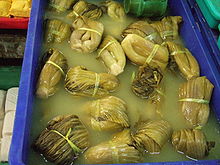Suan cai
| Suan cai | |||
|---|---|---|---|
 A tub of suancai made from Chinese mustard. | |||
| Chinese | 酸菜 | ||
| Hanyu Pinyin | suān cài | ||
| Literal meaning | Sour vegetable | ||
| |||
| Alternative Chinese name | |||
| Chinese | 鹹菜 | ||
| Hanyu Pinyin | xián cài | ||
| Literal meaning | Salty vegetable | ||
| |||
Suancai (also called suan tsai and Chinese sauerkraut; lit. 'sour vegetable') is a traditional Chinese pickled Chinese cabbage (napa cabbage) or Chinese mustard, used for a variety of purposes. Suancai is a unique form of paocai, due to the ingredients used and the method of production.
Production[]

Two distinct types of suancai are found in China:
- Northern China has used Napa cabbage (Chinese: 大白菜; pinyin: dà bái cài) as the traditional vegetable of choice.
- Southern and Western China uses the thick stalk varieties of Chinese mustard (Chinese: 芥菜; pinyin: jìe cai; Jyutping: syun1 coi3) variety to make suancai.
Production of suancai differs from other paocai in that the vegetable is compressed. This is accomplished by placing a heavy weight such as a large rock on top of the cover of the container so that the Chinese cabbage inside the container is slowly pressed as fermentation takes place. The processing of the vegetable helps to create a distinct flavor.
Suancai is often used in cooking with meat, especially pork. It is said[by whom?] to neutralize the grease of meat.
Regional[]
Muslim regions in mainland China and Taiwan[]
| Part of a series of articles on |
| Chinese Islamic cuisine |
|---|
 |
| Dishes |
In Chinese Islamic cuisine, suancai can top off noodle soups, especially beef noodle soup.
Hunan[]
In Hunan, suancai is frequently made with ginger and chilies (typical of Hunan cuisine).
Guangdong and Hong Kong[]
In Cantonese cuisine, it is served in a small dish, often as an appetizer, and usually free. Sometimes it can be available in mini-containers on the dining table. There are also Cantonese variations such as salted suancai (鹹酸菜).
Northeast China[]

In Northeastern Chinese cuisine, suancai is made from napa cabbage or head cabbage[citation needed] and has a taste similar to sauerkraut. As part of the cuisine in Manchuria, it is used with dumplings and boiled, or stir fried. More frequently, suancai is used to make suancai and pork stew.
Hot pot[]
In hot pot cuisine, it is often one of the ingredients.
Sichuan[]
In Sichuan cuisine, the dish Suancai yu (simplified Chinese: 酸菜鱼; traditional Chinese: 酸菜魚; pinyin: Suāncài yú) uses suancai. This dish is served in a broth.
In Thailand[]

Suancai has also been incorporated into Thai cuisine, where it is known as phak kat dong (ผักกาดดอง) when only the upper stem and leaf are used'. Most often used in Thai-Chinese dishes, it can also be served as an ingredient in a Thai salad, or as a condiment such as with khao soi, a northern Thai curry-noodle soup. The chopped sour leaf and upper stem is combined with scrambled egg in the dish pak khat dong pat kai. When the dish includes only the main stem and tuber of the cabbage (in the style of zha cai), it is called chee chuan chai in Thai.
In Vietnam[]
Pickled cabbage or dưa cải chua is a traditional staple in northern Vietnamese cuisine. It is used in dishes such as canh cải chua (sour cabbage soup) or cơm rang dưa bò (fried rice with beef and pickles).
Comparison[]
Suancai is similar to a fermented-cabbage dish, sauerkraut, which is common in the cuisines of Central and Eastern Europe.
In popular culture[]
A popular sitcom and namesake song depicting lives in Northeast China, entitled "Cui Hua Shang Suancai" (翠花, 上酸菜, literally "Cui Hua, serve the suancai") debuted in 2001, and the phrase Cui Hua Shang Suancai became a popular catch phrase. Cui Hua became synonymous with a person from Northeast China. A company in China registered "Cui Hua" brand packaged suancai.[1]
See also[]
- Sauerkraut – A finely cut raw cabbage fermented by various lactic acid bacteria
- Kimchi – a Korean dish made with fermented cabbage in chili peppers
- Zha cai – Pickled mustard plant stem from Chongqing, China
- Tianjin preserved vegetable – Type of pickled Chinese cabbage originating in Tianjin, China
- Meigan cai – Type of dry pickled Chinese mustard
- List of cabbage dishes – Wikipedia list article
References[]
External links[]
- Cabbage dishes
- Cantonese cuisine
- Chinese Islamic cuisine
- Chinese pickles
- Northeastern Chinese cuisine
- Plant-based fermented foods
- Vegetable dishes